#Sibbald
Text

Abbey Strand Physic Garden, Edinburgh
#due to a series of misjudgments I got soaked to the bone however it was a very interesting field trip#Edinburgh#the forecast said there would only be a wee bit of rain I trusted it and didn’t bring a jacket with a hood#I had also forgotten about the field trip#cut to me looking like a drowned rat after being in the pouring rain for hours#but I actually had a really good time#interestingly this garden is at/near the site of the garden which would eventually become the royal botanic garden edinburgh#started by sibbald and balfour 353ish years ago#then moved to where waverly station is then to leith walk then to inverleith where it is now#also top tip if you don’t want tourists in your photos visit places when it is raining heavily and freezing cold
5 notes
·
View notes
Text
youtube
The Accüsed - Boris The Spider
#the accüsed#boris the spider#the who#cover#blaine cook#tommy niemeyer#alex sibbald#josh sinder#hardcore punk#thrashcore#punk metal#splattercore#grinning like an undertaker#1990#Youtube
13 notes
·
View notes
Text



Travel back [...] a few hundred years to before the industrial revolution, and the wildlife of Britain and Ireland looks very different indeed.
Take orcas: while there are now less than ten left in Britain’s only permanent (and non-breeding) resident population, around 250 years ago the English [...] naturalist John Wallis gave this extraordinary account of a mass stranding of orcas on the north Northumberland coast [...]. If this record is reliable, then more orcas were stranded on this beach south of the Farne Islands on one day in 1734 than are probably ever present in British and Irish waters today. [...]
Other careful naturalists from this period observed orcas around the coasts of Cornwall, Norfolk and Suffolk. I have spent the last five years tracking down more than 10,000 records of wildlife recorded between 1529 and 1772 by naturalists, travellers, historians and antiquarians throughout Britain and Ireland, in order to reevaluate the prevalence and habits of more than 150 species [...].
In the early modern period, wolves, beavers and probably some lynxes still survived in regions of Scotland and Ireland. By this point, wolves in particular seem to have become re-imagined as monsters [...].
Elsewhere in Scotland, the now globally extinct great auk could still be found on islands in the Outer Hebrides. Looking a bit like a penguin but most closely related to the razorbill, the great auk’s vulnerability is highlighted by writer Martin Martin while mapping St Kilda in 1697 [...].
[A]nd pine martens and “Scottish” wildcats were also found in England and Wales. Fishers caught burbot and sturgeon in both rivers and at sea, [...] as well as now-scarce fishes such as the angelshark, halibut and common skate. Threatened molluscs like the freshwater pearl mussel and oyster were also far more widespread. [...]
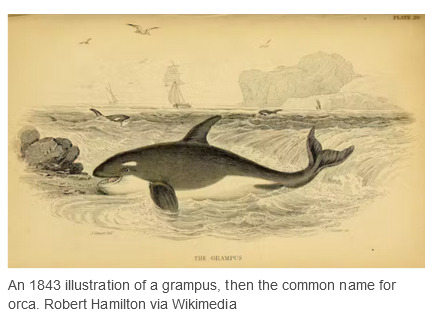
Predators such as wolves that interfered with human happiness were ruthlessly hunted. Authors such as Robert Sibbald, in his natural history of Scotland (1684), are aware and indeed pleased that several species of wolf have gone extinct:
There must be a divine kindness directed towards our homeland, because most of our animals have a use for human life. We also lack those wild and savage ones of other regions. Wolves were common once upon a time, and even bears are spoken of among the Scottish, but time extinguished the genera and they are extirpated from the island.
The wolf was of no use for food and medicine and did no service for humans, so its extinction could be celebrated as an achievement towards the creation of a more civilised world. Around 30 natural history sources written between the 16th and 18th centuries remark on the absence of the wolf from England, Wales and much of Scotland. [...]

In Pococke’s 1760 Tour of Scotland, he describes being told about a wild species of cat – which seems, incredibly, to be a lynx – still living in the old county of Kirkcudbrightshire in the south-west of Scotland. Much of Pococke’s description of this cat is tied up with its persecution, apparently including an extra cost that the fox-hunter charges for killing lynxes:
They have also a wild cat three times as big as the common cat. [...] It is said they will attack a man who would attempt to take their young one [...]. The country pays about £20 a year to a person who is obliged to come and destroy the foxes when they send to him. [...]
The capercaillie is another example of a species whose decline was correctly recognised by early modern writers. Today, this large turkey-like bird [...] is found only rarely in the north of Scotland, but 250–500 years ago it was recorded in the west of Ireland as well as a swathe of Scotland north of the central belt. [...] Charles Smith, the prolific Dublin-based author who had theorised about the decline of herring on the coast of County Down, also recorded the capercaillie in County Cork in the south of Ireland, but noted: This bird is not found in England and now rarely in Ireland, since our woods have been destroyed. [...] Despite being protected by law in Scotland from 1621 and in Ireland 90 years later, the capercaillie went extinct in both countries in the 18th century [...].
---
Images, captions, and text by: Lee Raye. “Wildlife wonders of Britain and Ireland before the industrial revolution – my research reveals all the biodiversity we’ve lost.” The Conversation. 17 July 2023. [Map by Lee Raye. Bold emphasis and some paragraph breaks/contractions added by me.]
1K notes
·
View notes
Text
Of the Monstrous Pictures of Whales
In my very informed opinion it is absolutely essential to read Chapter 55 with visual aids. Here are some highlights pulled from Ishmael's Most Hated depictions so we can all be on the same page about what whales definitely don't look like.
Guido Reni & William Hogarth get the benefit of the doubt on account of the fact that it never says Perseus's sea monster is a whale. We can all agree that these definitely are not:


2. Robert Sibbald was the first naturalist to officially describe a blue whale and I'll give him a pass on being first and blue whales being incomprehnsibly large even now, but this really is not accurate in pretty much any way.
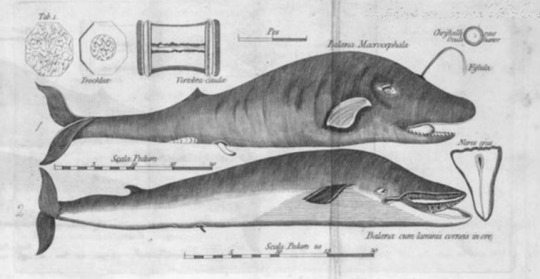
See below the cut for more "monstrous" depictions!


4. Oliver Goldsmith's An History of the Earth and Animated Nature is truly a treasure. Per Ishmael "I do not wish to seem inelegant, but this unsightly whale looks much like an amputated sow". The illustration on the right isn't directly mentioned in here but honestly it's a treasure and I feel obliged to share it with you. There's too much going on there for me to possibly pick out highlights. They're so bad they're perfect. No notes.

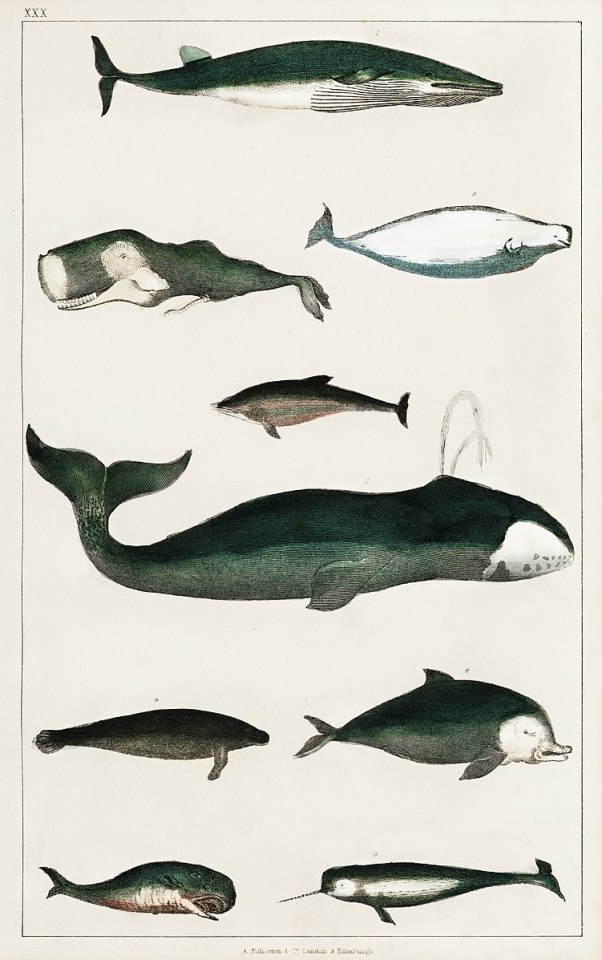
5. Bernard Germain, defying the laws of physics here. "Not only incorrect" but also does "not to have its counterpart in nature"
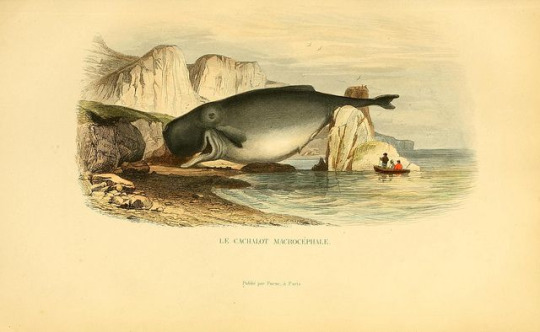
6. Cuvier's Sperm whale is "not a sperm whale but a squash." Succinct and shady. Perhaps my favorite description in the entire chapter.
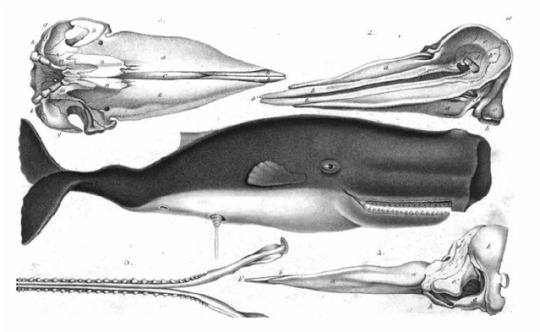
#whale weekly#moby-dick#yes i did prep this in advance#yes i regularly think about the phrase “not a sperm whale but a squash”#why i've latched onto that one i couldn't tell you
297 notes
·
View notes
Text
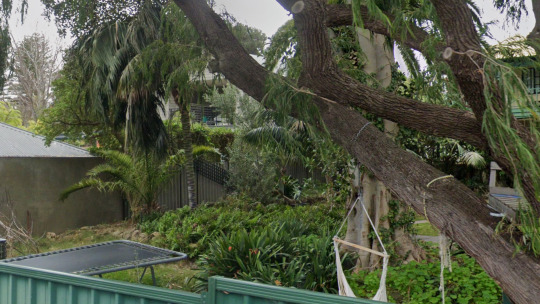
Sibbald Ln, Mosman Park (Perth).
103 notes
·
View notes
Photo

2023 April 24
The Medulla Nebula Supernova Remnant
Image Credit & Copyright: Kimberly Sibbald
Explanation: What powers this unusual nebula? CTB-1 is the expanding gas shell that was left when a massive star toward the constellation of Cassiopeia exploded about 10,000 years ago. The star likely detonated when it ran out of elements near its core that could create stabilizing pressure with nuclear fusion. The resulting supernova remnant, nicknamed the Medulla Nebula for its brain-like shape, still glows in visible light by the heat generated by its collision with confining interstellar gas. Why the nebula also glows in X-ray light, though, remains a mystery. One hypothesis holds that an energetic pulsar was co-created that powers the nebula with a fast outwardly moving wind. Following this lead, a pulsar has recently been found in radio waves that appears to have been expelled by the supernova explosion at over 1000 kilometers per second. Although the Medulla Nebula appears as large as a full moon, it is so faint that it took many hours of exposure with a telescope in Seven Persons, Alberta, Canada to create the featured image.
∞ Source: apod.nasa.gov/apod/ap230424.html
153 notes
·
View notes
Photo

Killer whales travel, eat, play, and rest together. From "Sea mammals: the warm-blooded ocean explorers" by Jean Sibbald, 1988. https://www.instagram.com/p/CiNvQyRtF0D/?igshid=NGJjMDIxMWI=
350 notes
·
View notes
Photo

The Lavellan is a toxic mammal found in northern Scotland, primarily Caithness.
A lavellan’s appearance is unclear and unassuming; at the very least, it is believed to be small and furry. Sibbald believed it had the head and color of a marten, while other accounts describe it as resembling a shrew or a lizard. It has bright eyes and moves very quickly.
Lavellans are highly poisonous, and are capable of harming cattle from forty yards away. Their very breath is noxious. They are also lethal to humans, as told in one satirical song: “Let him not go away from the houses, to moss or wood, lest the Lavellan come and smite him”.
Farmers kill lavellans on sight and preserve their skin. Water in which a lavellan skin has been dipped is a certain remedy for lavellan poisoning. Boiling a lavellan head will also provide an antidote.
It has generally been assumed that the lavellan is a demonization of the water shrew, also known locally as water mole or blind mouse. The shrew’s saliva is mildly toxic but nowhere near as virulent as the lavellan’s. Harvie-Brown and Buckley, on the other hand, propose that the common lizard – brownish in color, bright-eyed, swift, and unfamiliar – was the originator of the lavellan. It may well be a combination of both.
Text from @a-book-of-creatures (entry)
#lavellan#Scotland#folklore#Supernatural in Scotland#a-book-of-creatures#crayon#illustration#chimera#yeahhh another one#bestiary#creature design#monster
134 notes
·
View notes
Text
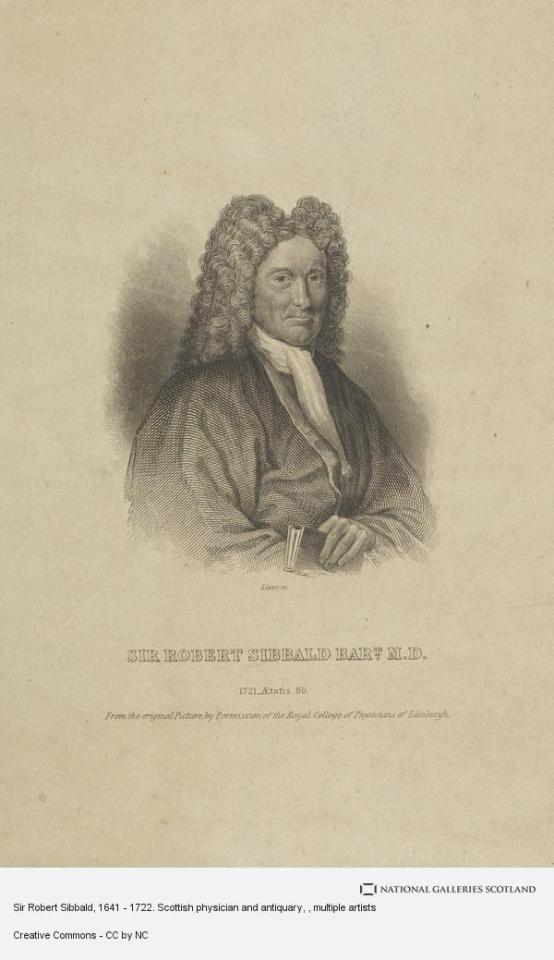
On the 15th of April 1641 Sir Robert Sibbald, physician and geographer was born.
His mother was Margaret Boyd, eldest daughter of Robert Boyd of Kipps, Linlithgowshire and it was to there they fled when Robert was still a bairn, escaping an outbreak of the plague in the Capital.
In his autobiography, Sibbald describes his mother as: 'a virtuous and pious matron of great sagacity and firmness of mind and very careful of my education'. She died at Kipps, leaving the estate to Robert.
Following a theological course in Edinburgh, Sibbald studied medicine in Leyden and Paris, and from Angiers he obtained his licence to practise medicine.
His first appointment was as Geographer Royal for Scotland to Charles II, and he was knighted at Holyrood Palace in 1682. In 1685 he was appointed the first Professor of Medicine (without salary) to Edinburgh University.
He established the first botanical and physic garden in the yards of Holyrood Abbey for instructing students in botany and supplying apothecaries with vegetable "materia medica."
8 notes
·
View notes
Text
My Dream Role as an Environmental Interpreter
Growing up, I loved opportunities to go on camping trips to various provincial parks in Ontario. I remember visiting Balsam Lake, Sibbald Point, Six Mile Lake, Killbear and Wasaga Beach Provincial Park. I loved exploring these natural areas and discovering new landscapes and environments within Ontario.

A picture I took at Cape Breton Highlands National Park in Nova Scotia.
My ideal role as an environmental interpreter would be as a park interpreter at a provincial or national park within Canada. My role as park interpreter would involve assisting visitors to explore park trails and swimming areas while providing informational programs safely and respectfully. I would love to run programs such as nature journaling, biodiversity hikes or games such as Wolf Prowl which allows kids to take on roles as animals in an ecosystem. I would also like to help run evening programs that permit visitors to safely explore the trails in the dark which they might not do on their own. As a park interpreter, I would like to focus some programs on establishing people's relationships with nature and sustainability.
The job of an environmental interpreter would require a variety of skills to deliver effective and meaningful interpretation. The skills I first thought of included plant and animal identification and knowledge of ecology, geology, and environmental stewardship. Additional skills in mapping, GPS, and first aid would also be crucial in a role as a park interpreter. Skills in these areas will allow me to be a reliable source of information that visitors can trust with their questions regarding the natural heritage of conservation areas. These areas of knowledge and skills I have listed are essential for environmental interpretation, however, I do not think they are the most important.
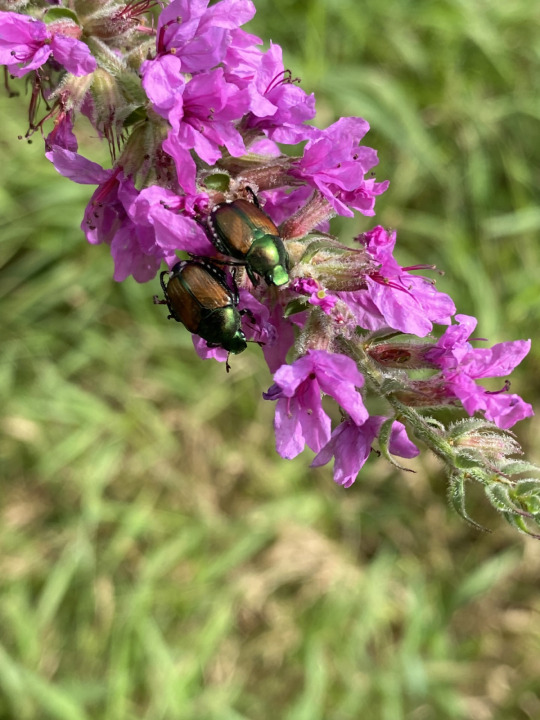
A picture I took of a Japanese beetle (Popillia japonica) on a hike on the Brook Trail in Uxbridge.
Before having the opportunity to work in outdoor education and to read the textbook, Interpreting Cultural and Natural Heritage: For A Better World, I thought knowledge of the environment would be the most important skill to have as an interpreter. However, you could have all the knowledge of nature possible but if you cannot communicate with individuals then you will not be able to effectively share the beauty of nature with others. As described by Beck et al. (2019), communication is the core of cultural and natural interpretation.
In an environmental interpreter role, I would need to be skilled in applying different learning theories and styles to communicate natural surroundings to a diverse group of people. Having the ability to use the Cognitive Development Theory through numerous interpretation forums will allow me to interact with different age groups (Beck et al., 2019). Also, having skills working with multiple intelligences will allow me to connect with a variety of people who learn in different ways (Beck et al., 2019).

A photograph I took in British Columbia at a Natural heritage site.
As an outdoor education intern, I saw many kids with different interests and ways of learning. Some kids connected better to lessons involving games such as Predator-Prey where they got to run around but still learnt about ecosystem functions. Other kids preferred to explore ecosystems through nature journaling or nature photography programs. All kids were able to leave the outdoor education center with new knowledge and new feelings toward the environment through different pathways.
By utilizing my knowledge of the environment with communication and teaching skills I could succeed as an interpreter at a natural heritage site such as provincial or national parks. Communicating my understanding of different environments and sharing my passion for nature would allow me to guide people to form their own connections and ideas of nature.
References
Beck, L., Cable, T. T., & Knudson, D. M. (2019). Interpreting cultural and natural heritage: For A Better World. Sagamore Publishing.
7 notes
·
View notes
Text
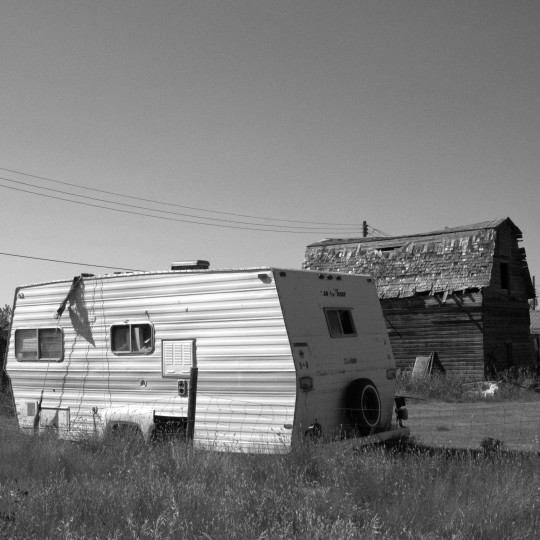
Sibbald, Alberta
#jlepape#monochrome#blackandwhite#bnw#photographers on tumblr#photooftheday#landscapephoto#bw_lover#photography#alberta#abandoned
78 notes
·
View notes
Photo

Cryptids & Creatures of Folklore Drawtober Day 15 — High-Finned Sperm Whale
In 1687, physician Sir Robert Sibbald described what he believed to be a new species of whale. Sibbald encountered a beached animal which was similar in appearance to known sperm whales aside from one significant difference—he claimed the female animal had a very tall dorsal fin. Sibbald dubbed the species Physeter tursio.
Another of these High-Finned Sperm Whales was spotted in 1946 in the Annapolis Basin of Nova Scotia where the animal was trapped for two days.
#drawtober#cryptids#cryptozoology#whales#illustrations#art#high-finned sperm whale#sperm whale#giant squid#I remembered squids have blue blood#after I already put some red blood there lol#colored pencils are so forgiving#and they can hide so many sins lol
98 notes
·
View notes
Text
Gin made with botanicals from the Palace of Holyroodhouse launched
The Royal Collection Trust has launched a dry gin using botanicals from the gardens of the Palace of Holyroodhouse 🏴
By Lauren Gilmour
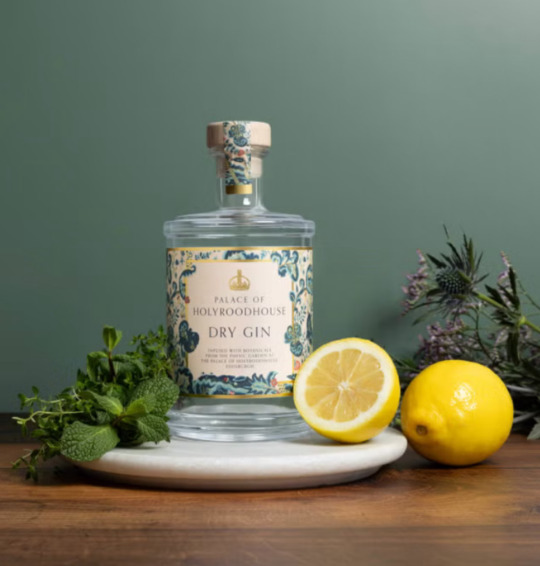
A dry gin infused with botanicals grown in the gardens at the Palace of Holyroodhouse in Edinburgh has become the latest spirit to be launched by the Royal Collection Trust (Royal Collection Trust/His Majesty King Charles I|| 2024)
A dry gin infused with botanicals grown in the gardens at the Palace of Holyroodhouse in Edinburgh has become the latest spirit to be launched by the Royal Collection Trust.
Each gin is flavoured with ingredients sourced from the grounds of the Official Royal Residences.
The Palace of Holyroodhouse Dry Gin is infused with mint and lemon thyme hand-picked from the palace’s Physic Garden.
Inspired by the garden’s history of cultivating medicinal and culinary herbs, the botanicals – which are steeped for 24 hours before the distilling process begins – combine with juniper to create a delicately fragrant gin with a complex citrus top note.
The Physic Garden was opened adjacent to the palace in 2020 to recreate the earliest known gardens on the site.
It can be freely enjoyed year round by the people of Edinburgh and visitors to the Palace.

The Physic Garden on the grounds of the Palace of Holyroodhouse opened in 2020 (Royal Collection Trust/His Majesty King Charles 111 2024)
Originally founded in the grounds of the palace in 1670 by two Scottish physicians, Sir Robert Sibbald and Sir Andrew Balfour, it provided fresh ingredients for pharmacists and allowed students to learn the medicinal properties of plants.
It was the first garden of its kind in Scotland and was the forerunner of the Royal Botanic Garden Edinburgh.
Today, visitors to the Physic Garden will see plants such as fennel, lavender, and lemon balm growing as well as a meadow of wildflowers with healing properties.
The floral bottle design of the gin is inspired by the 17th century Scottish textiles seen on the bed in Mary, Queen of Scots’ bedchamber inside the palace.
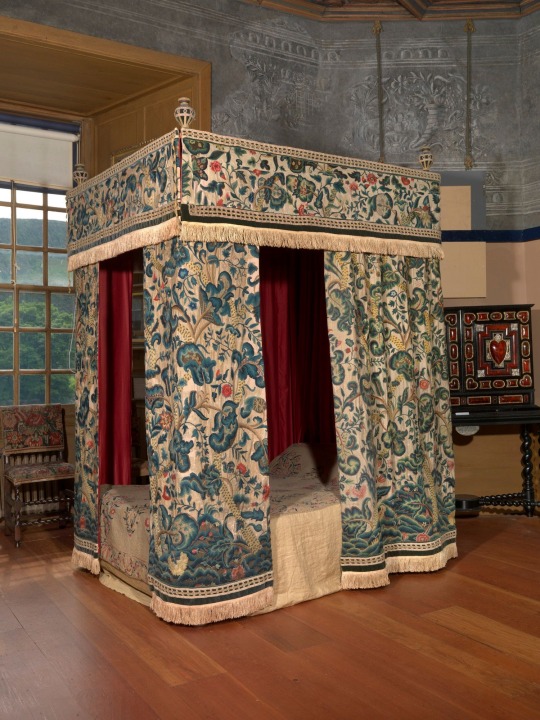
The bottle design is inspired by the 17th-century Scottish textiles seen on the bed in Mary, Queen of Scots Bedchamber inside the Palace (Royal Collection Trust/His Majesty King Charles III 2024)
All profits from sales of the gin go towards the care of, and access to, the Royal Collection through the public opening of the Royal Residences, exhibitions, loans, and educational programmes managed by Royal Collection Trust, a registered charity.
@independent

PALACE OF HOLYROODHOUSE DRY GIN
New
£40.00
PALACE OF HOLYROODHOUSE DRY GIN is Cheaper than SH’s Sassenach Wild Scottish Gin and is crafted in the heart of Edinburgh 🏴
*Due to international shipping restrictions, this item is only available for delivery to addresses in the United Kingdom, Germany, New Zealand and Australia.
6 notes
·
View notes
Text
The jaws of it stand for a gate in the garden of Pitferren.” —Sibbald’s Fife and Kinross
“I built a cottage for Susan and myself and made a gateway in the form of a Gothic Arch, by setting up a whale’s jaw bones.” —Hawthorne’s Twice Told Tales.
“Pedestrians in the vicinity of London and elsewhere may recollect having seen large curved bones set upright in the earth, either to form arches over gateways, or entrances to alcoves, and they may perhaps have been told that these were the ribs of whales.” —Tales of a Whale Voyager to the Arctic Ocean.
I really love the several whale quotes that talk about whale bones, ribs, and jaws being made into gates and archways. There’s something so awe inspiring in that image of giant whale jaws being made into a gateway. What a way to show how immense and god-like whales are. And then to see it being repeated again and again throughout history. There is so much meaning in the repetition.
7 notes
·
View notes
Text

The Medulla Nebula Supernova Remnant.
Tracy Sibbald
seasoflife
6 notes
·
View notes
Text
Random historical note: throughout The Flight of the Heron, Keith Windham (and other Government officers) routinely identify this person or that as Clan Cameron because of their plaid. I assumed this was a goof on Broster’s part, given that clan tartans were a Victorian invention.
But lo, here I am reading John Sibbald Gibson’s Lochiel of the ‘45:
Such then was Lochiel's regiment which set out from Glenfinnan... It would be to some extent uniformly clad; in the months before the Rising Lochiel had ordered plaids from Glasgow for his men (how we would wish to know what, if any, tartan was specified!)
Perhaps no other Highland clan could be identified the sett of their plaids during the 1745 Rising, but Clan Cameron could! My sincerest apologies, Ms. Broster, for doubting the thoroughness of your research!
#donald cameron 19th lochiel#jacobite rising of 1745#clan cameron#the flight of the heron#d.k. broster#who knows what tartan they actually wore in that year#but they did all wear the same one!
17 notes
·
View notes